Join the Goonhammer Historicals team as we take a look at the brand new Far East 1941-45 Handbook for Chain of Command. So get a good grip on your machete and let’s dive into the deep, dark jungle!
Last week, Too Fat Lardies released their much-anticipated Far East 1941-45 Handbook for their flagship Chain of Command WW2 platoon-scale wargame. And when I say, “much anticipated,” I mean that rumors of its release have been rumbling around for literal years now. Sadly, COVID-related delays and other complications pushed back the release date numerous times. But by the gods it’s finally out and in my hot little hands. And spoiler alert: It was absolutely worth the wait.
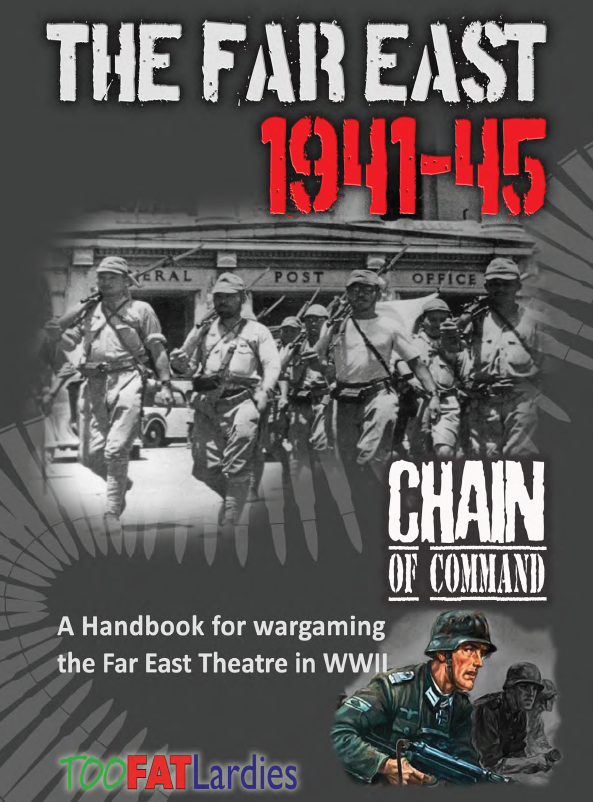
The Premise
While many people point to Nazi Germany’s invasion of Poland in September of 1939 as the beginning of the Second World War, it can be argued that tensions in the Indo-Pacific region started much earlier with the Japanese invasion of Manchuria on the 18th of September, 1931. This was Japan’s foray into becoming a colonial power in direct competition with European states who’d been mucking things up in the region for the preceding four centuries.
Japan’s territorial ambitions in mainland Asia were frustrated by the fact that China was unsurprisingly full of Chinese people who had very different ideas about being ruled by a foreign power. Also, China is really freaking big. What was initially meant to be a rapid campaign of conquest instead turned into a grinding drain on Japan’s otherwise burgeoning economy. The brutality of Imperial Japan’s treatment of the Chinese civilian population in particular (as demonstrated by the Rape of Nanking in 1937) shocked the world and resulted in increasing pressure put on Japan by its erstwhile trading partners. With the Japanese seemingly undeterred (indeed, in mid-1940 they browbeat the Vichy French government into allowing them basing and military transit rights in French Indochina – modern day Vietnam – to better attack into southern China), these sanctions were steadily ratcheted up, culminating with the United States instituting a full oil embargo in July of 1941. Given that Imperial Japan only had somewhere between 12 and 18 months of oil reserves this measure – meant to forestall a war – started a ticking timebomb that would have exactly the opposite effect.
That bomb exploded on December 7th, 1941, with the Japanese attack on the American Pacific Fleet’s base at Pearl Harbor. This attack was timed to coincide with offensives all over the Pacific aimed at stripping western nations of their former colonial possessions and crippling their ability to respond. With the British already heavily committed in North Africa, Imperial Japan reckoned that there was no better time to strike. In quick succession, Hong Kong and British Malaya joined the Philippines and the American-held islands of Wake and Guam in seeing Japanese invasion forces storm and overwhelm them entirely. A month later, the oil-rich Dutch possessions in the East Indies (modern day Indonesia) would be similarly attacked. With stunning swiftness, Japan seemed poised to finally realize its imperial ambitions.
The Allies would spend the next four years slowly clawing back those swift initial gains.
What’s In The Book
At a hefty 120 pages, the Far East handbook is packed with all sorts of goodies, with army lists, new rules, rules modifications, and a handful of scenarios that highlight the kinds of fighting that typify combat in this theater. Let’s take a closer look at each of these.
Army Lists
Chain of Command places a strong emphasis on providing players with historically accurate forces upon which to base their tabletop armies. The bulk of the book deals with the platoon organizational rosters that anyone already familiar with Chain of Command will be well-acquainted. These include not only the unit organizations themselves, but also the likely support options available to each of those platoons individually. And these support options include the usual suspects of adjutants and medics and snipers and such, as well as armor and air support.
While there are only sections for three “nationalities” (the British, the Dutch, and the Japanese), all of these are truly multi-national affairs. The British section for instance includes lists for troops raised from the populations of India, Burma, and Assam. The Japanese section gives players the option of fielding a platoon of the Indian National Army, comprised of Indian troops formerly in British service who switched sides after the fall of Singapore. The history of the INA is fascinating and bound up in India’s own ambitions for independence from British rule, a sentiment that the Japanese very much wanted to foment.
One of the things that really distinguishes these lists from previous supplements is the specificity associated with when and where they were fielded. For instance, there are 28 different platoon lists for the British Empire (the largest block), with some of these having additional differentiating options such as whether or not you’re fielding the platoon as a force of Regulars or Gurkhas. While one might argue that this is somewhat excessive, it reflects the fact that the fighting took place in widely dispersed locations and over a very broad timespan. So while the organization and equipment of the standard Commonwealth infantry platoon really didn’t change much over the course of the war, there is a pretty huge difference in capability between a British platoon defending Singapore in 1941 versus one attacking Mandalay in 1945. Similarly, Australian troops fighting in Papua and New Guinea who already had experience in jungle warfare are going to play very differently to the Hong Kong Volunteer Defense Corps formed largely of civilian militia.
The biggest change to the army lists is that each now has a “Jungle Training” stat, being either Poor, Experienced, or hardened Jungle Warriors. This stat reflects the unit’s ability to perform well in jungle terrain, and affects their movement, shooting, and logistics. This last “logistics” bit is important because the Far East Handbook includes a new “Lines-of-Communication” mechanic that offers another way to attack your opponent’s Force Morale; if you can outmaneuver your opponent and squat on their line-of-communication to the rear, they’ll take a guaranteed hit to Force Morale at then end of every Turn until it’s cleared. Chain of Command has always reflected this in some respects by allowing you to close down and/or capture your opponent’s Jump-Off Points, but that was a one-time penalty. This new mechanic gives an interesting ongoing mechanism that really rewards aggressive movement – especially in rough terrain.
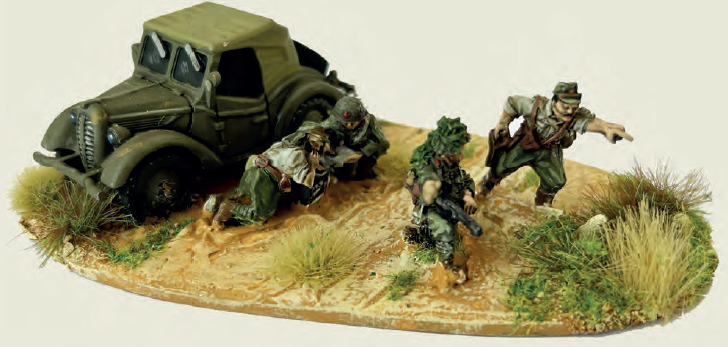
One of the things that further distinguishes between units are the tables that indicate the Force Morale levels at which a unit begins to suffer from a loss of command and control in the form of lost Command Dice or forced retreat to a Jump-Off Point. An innovation in the Blitzkrieg 1940 Handbook, these differences between what might otherwise seem to be identically organized platoons can have a pretty strong effect on the tabletop, especially in the later part of the game where your Force Morale is starting to falter. The “Red Die” (an additional Command Die that can be used for unit activations) also makes its return as a potential support option for well-led forces, with some particularly aggressive units getting one for free.
Armor is also handled a little differently in this supplement; rather than including various tanks and armored cars in the support lists themselves, separate “armor lists” are given by specific location and timeframe. Many of the British possessions in particular had older (or even already-obsolete) armored vehicles. What was available for the defense of Hong Kong differed from what was available for the defense of Singapore, for instance, even though both fights were happening at roughly the same time. And of course this differs greatly from the armored units available to the British during their push into Burma later in the war. Given the rapid development of armored vehicles over the long course of the war covered by this supplement, I think this is a great way to handle deciding what is or isn’t available. It does place some onus on the players to decide when and where the events on the tabletop is supposed to be taking place, but given that Chain of Command tends to be more focused on recreating historic actions (as opposed to pick-up games) this seems like a reasonable way to handle armor.
For players who want to “mix and match” a little bit more, the concept of “Unreliable Allies” first introduced in the Blitzkrieg 1940 Handbook has been included. This is great, because so swift were the Japanese advances that different allied units (occasionally including units from different nations) became intermingled. The Unreliable Allies rule can give players access to a wider variety of potential supports, with the downside that at any point those allies may get countermanding orders from their own chain of command and be forced to quit the field.
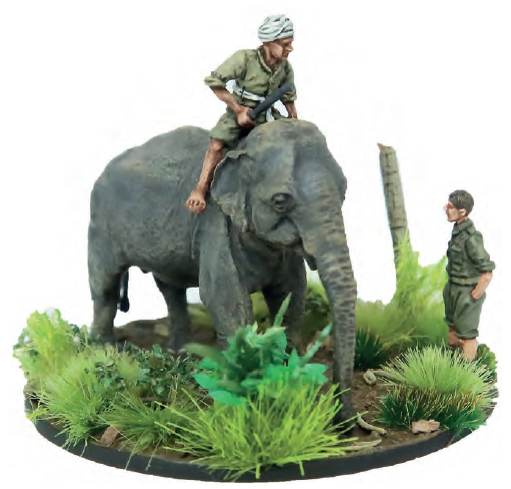
Rules Modifications
One of the biggest changes introduced in this new handbook is how CoC handles “green” troops. In the main rules, green troops were easier to hit and suffered a penalty to their initial Force Morale roll. With the Far East handbook, green troops have the same “to hit” number as regular troops, but suffer increased negative effects to their own shooting and melee from Shock. Overall, this change means that green troops are as resilient as regulars but less effective offensively. This reflects the idea that while even inexperienced troops are smart enough to duck when getting shot at, it takes training and experience to overcome that fear and return effective fire. This new rule feels like it strikes a good balance, and will keep some of the ad hoc and militia defense forces from getting absolutely steamrolled. This in turn will lead to better games that include those units.
Another thing that has undergone some flux over the years since CoC’s initial release is how the game handles grenades. The big sticking point here is the question of how many grenades it is appropriate for a force to be carrying, and the Far East handbook is the third iteration of answering this question. Now for the first time, each force is explicitly given a number of grenades it can use before running out, though the new “Limited Ammunition” rule allows a player to expend a full Chain of Command die (itself a precious resource) to get more if the situation is dire enough to warrant it.
Jungle Rules!
And of course, what book about fighting in southeast Asia would be complete without jungle rules! This is the part of this supplement that I was personally most looking forward to. Jungle fighting – often in rough, mountainous terrain – characterized much of the fighting in Indonesia, Malaya, and Burma. A familiarity with combat operations in this difficult terrain was one of the keys to Imperial Japan’s early successes. For this section of the book, the Lardies crew enlisted the help of Len Tracey. A military historian and long-time contributor to the TFL forum community (he wrote the excellent Malaya 1942 Pint-Sized Campaign that appeared in the 2015 Lardie Christmas Special), Len used to run the Australian army’s Jungle Warfare School. His expertise comes through brilliantly, and the resulting rules for jungle combat really capture the claustrophobic nature of this unique environment.
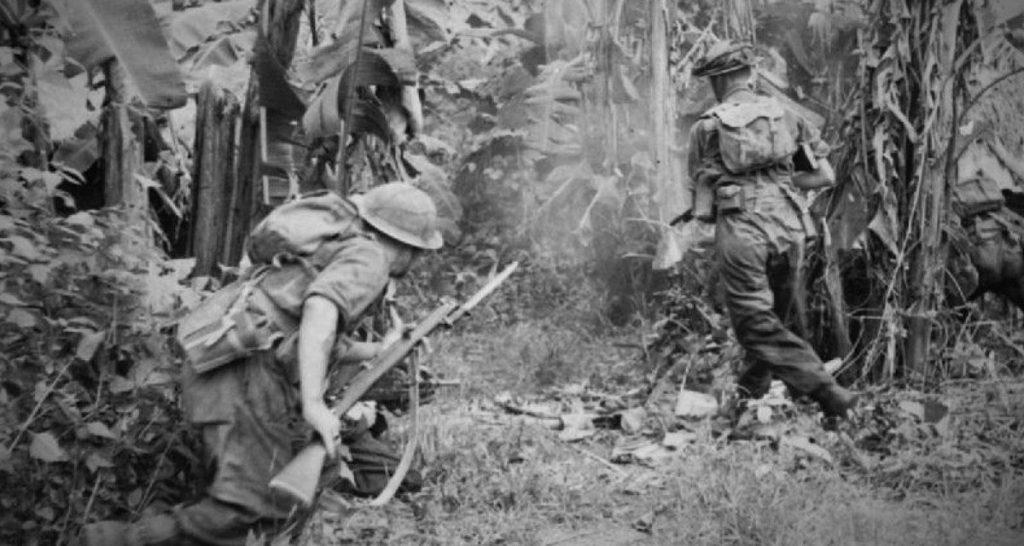
While there are rules for movement and visibility that distinguish between several different types of jungle terrain (from the dim, high-canopied primary jungle to the dense, tangled undergrowth of the “jungle fringe” to thickets of bamboo and chest-high kunai grass and more), the rules also include more simplified options for players who want to include some jungle terrain on their table but don’t want to get into the nitty-gritty of the different types. Similarly, firefights in the jungle are a fraught affair, and the rules introduce the concept of the “Green Die,” which adds a randomizing effect to the amount of effective cover provided against shooting attacks. Here too there is both a simplified, standard option and an advanced option for players who want a more detailed approach. The advanced option reflects the additional effects of units’ relative experience at jungle warfare and will make veteran “Jungle Warriors” a fearsome foe indeed!
There are a few other additional terrain rules to reflect different kinds of watercourses and the effects of rough, mountainous terrain. One of my favorites is the new “Monsoon” terrain rule, which captures the effects of extended, torrential downpours endemic to so much of the region.
Another complicating effect of jungle warfare is an increased likelihood of random events, which can occur at the end of each Turn (as opposed to only when four or more 6s are rolled on the Command Dice). These can include units getting lost (and potentially stumbling into the enemy!) as well as random casualties from heat exhaustion.
Taken collectively, I feel like the jungle rules are an excellent addition to the game and I really look forward to trying some of them out!
Other New Rules
This supplement introduces a brand new rule that is sure to send some Shock waves through the CoC community and spark all sorts of ideas: effects powered by the expenditure of Chain of Command pips rather than needing to wait for an entire Chain of Command Die to be accrued.
Previously, all of the “special effects” like springing ambushes, interrupting an opponent’s phase, ending the Turn, or the like were gated behind the accrual of a complete six points towards a “Chain of Command Die.” Now, there are a number of effects that can be activated by spending a partial die. Ambushes in particular are a big one, and troops in jungle terrain can spring an ambush by spending a number of pips based on their jungle skill level; more experienced jungle fighters have to spend fewer pips, one of the key effects of this potent skill.
Another really interesting potential use of this mechanism is using a single pip to activate a scout team. Essentially, this means that scouts can activate on a Command Die roll of either a 1 or a 5, doubling the chances that a scout team far removed from the command radius of the platoon’s leaders can activate. This is huge, as it makes scouting and maneuver a much more important part of the game – especially in the kind of close-in jungle terrain that heavily blocks lines of sight.
I think this partial expenditure concept is a fantastic addition to the game, and I really look forward to experimenting with it and seeing what future supplements and Pint-Sized campaigns do with it.
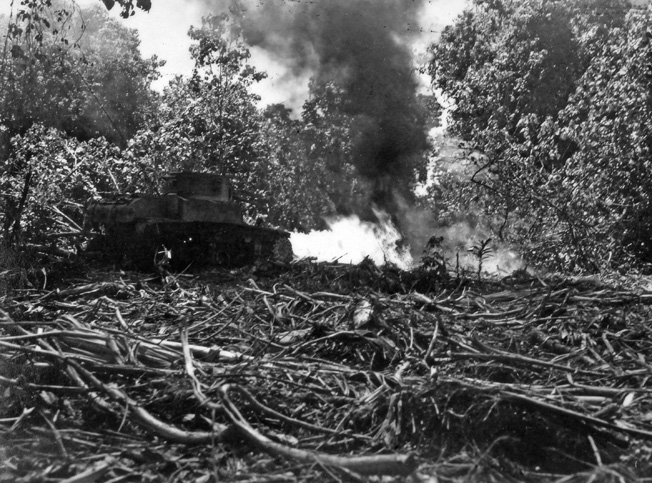
The last two sections of new rules are found in the section on the Japanese, which are expanded rules for “ruses” and fortifications. The Ruse was a support option that first appeared in the official list for the regular Imperial Japanese Army platoon that came out shortly after CoC’s initial release. It allowed the Japanese player to move a Jump-Off Point after the end of the Patrol Phase, which offered huge deployment advantages, allowing the Japanese force a better chance of straight up outflanking their opponents (something for which the early attacks by the Japanese in ’41 and ’42 were well known). The Far East supplement expands on this idea but offers a variety of different “sneaky tricks” available to the Japanese player.
Interestingly, the Japanese player may purchase multiple ruses, but doesn’t need to specify which they are buying and can use whichever is most advantageous given the circumstances (though no single ruse can be used more than once). This gives the Japanese player a ton of tactical flexibility. These are further broken down by era, with certain ruses available only in the early or late war. This includes the infamous “Banzai Charge.” Rather than being a generic “national characteristic” of the Japanese force, the need to purchase a List 2 support slot (where the Ruse sits) to power such a charge more accurately reflects the amount of planning and coordination that actually went into these kinds of attacks. This keeps a historical aspect of how the Japanese fought, but presents it in a way that is more measured and historically accurate.
The final section of new rules that really adds a lot to the game is the expanded section on fortifications. In addition to detailing the effects on firing and morale, these rules introduce a few new concepts like prepared lines of fire (which allow troops in the fortification to ignore jungle terrain 18″ immediately to their front for the purposes of making shooting attacks) and “ambush bunkers” (which are fortifications that can be placed on the board as an interrupt during an opponent’s phase and fire immediately). The Squad Prepared Position is also a really interesting rule, as it too provides for tactical flexibility and surprise in a way that feels very well-thought-out.
What’s Not In The Book
China. For all that the fighting in China was what precipitated much of the war in the Far East, army lists and details on the Chinese National Army and the Chinese Communists are entirely absent from the book. I think that there are good reasons for this – my impression is that there is very little primary source material on the organization, command structure, and tactics of the Chinese that has been translated into the English-language, making research a much more difficult and daunting task. I also get the sense that a lot of the formations that fought were ad hoc forces very much responding to the needs of the moment rather than some sort of cohesive doctrine, and constant supply issues complicate any attempts to describe a historically accurate TO&E. For instance, prior to the outbreak of fighting with Japan (and even during ongoing hostilities right up until 1940), China had actually been supplied by the Germans, and old photos of Chinese soldiers toting Kar 98s and wearing stahlhelms are pretty wild. While digging into the vast variety that these forces offer could very well be enough to cover a separate source book all in its own right, I was a little disappointed that the Chinese were entirely absent from the book.
[Editor’s Note: China will be in the Pacific book – it has been confirmed by TFL.]

Also absent are the Americans. For as sprawling as it already is, the Far East handbook is limited to the India/Burma/Malaya/Indonesia section of the theater. It mentions that the “island hopping” campaigns of the US military will be handled in an upcoming Pacific handbook, which is great news. It’s also not surprising, as the US Marine Corps alone changed their platoon organizational structure more often than my kids change their socks. Fortunately, the US Army’s platoon organization was largely unchanged throughout the war, so actions in which the Army took part (e.g. the defense of the Philippines, amphibious landings on Kwajalein atoll, fighting in the Solomons, Okinawa, etc) can easily be gamed out using the Japanese lists and jungle rules appearing in the Far East handbook.
The other thing I’d have liked to have seen here are comprehensive rules for night fighting. It is my fervent hope that with the jungle rules well handled in this Far East book that the Pacific sourcebook will tackle operations at night.
Overall Impressions
It is clear that a truly monumental amount of research went into this book. Both the depth and breadth of the material presented in the Far East Handbook are truly stunning. The historical information is presented in a way that makes sense and complements the specific details in the various army lists. New rules mesh well together without introducing too many new mechanisms.
Over the years the Too Fat Lardies have occasionally garnered the reputation for having a somewhat laissez faire approach to copy editing and specificity when it comes to the text of rules. In many ways this is understandable – it’s essentially a two-man outfit very much in the old-school-club-wargaming vein of “just hash out any rules disagreements amicably over a pint or two.” This is of course on top of Rich and Nick’s rather punishing convention and event schedules (because for as clever and innovative as their games are, games don’t sell themselves). And so it was with pleasant surprise that I noted exceedingly few errors or instances where something was unclear. The rules modifications and additions in particular are very clearly written.
Overall I am very impressed with the Far East 1941-45 Handbook. I think it’s an excellent addition to an already outstanding game. Chain of Command already does a fantastic job of handling asymmetric conflicts (which you can see in action in our playthrough of the Totensonntag Pint-Sized Campaign), and the variety of army lists, terrain types, and interesting rule nuances in this new supplement are going to provide a fantastic framework for gaming out some of these kinds of conflicts on the tabletop. I’m really looking forward to playing scenarios set in this theater of the war. I find myself inspired to tackle all sorts of new gaming projects, which is really the best you can ask for in a game supplement.
Now I just need to get cracking on building some jungle terrain!
If you have any questions or want to share your own impressions of the Far East 1941-45 Handbook, leave a comment below!


